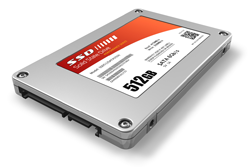How solid state drives can boost IT performance
 The standard hard drive has been the data storage workhorse of business computing for years. Virtually every computer and server in your company will have a hard drive inside it, which is used to store your files on a small magnetic disk.
The standard hard drive has been the data storage workhorse of business computing for years. Virtually every computer and server in your company will have a hard drive inside it, which is used to store your files on a small magnetic disk.
Hard drives are cheap, reliable and reasonably fast. But could the emergence of solid state drives (SSDs) spell the end for the hard drive?
What is a solid state drive?
Like hard drives, SSDs are a way to store data on your computer. They look very similar to hard drives, and in fact it usually only takes a few minutes swap a computer’s hard drive for an SSD.
SSDs use microchips to store data. The technology is that same as that used in digital camera memory cards and USB memory sticks. Unlike hard drives, SSDs have no spinning or moving parts, giving them a number of advantages:
- SSDs are much faster. Hard drives have to ‘spin up’ before they can read or write your data, and they have to locate that data on the magnetic disk. With no moving parts, SSDs can find and transfer the data much more quickly.
- Solid state drives are more robust. When dropped or subjected to a sudden shock, they are less likely than hard drives to drop in performance or fail altogether.
- SSDs use less power. Solid state drives contain no power-hungry motors – meaning that when used in laptops, they can make a noticeable difference to overall battery life.
These advantages make SSDs particularly well-suited to mobile computing, and their use in laptop and tablet computers is growing. However, there’s a big price difference between SSDs and hard drives.
A large SSD, capable of storing around 500GB of data (more than enough for most business computers) can cost well over £500. An equivalent hard drive could be less than £100. As a result, SSDs tend to be appear only in high-end laptops, like Apple’s MacBook Air.
When is an SSD right for business?
The obvious home for a solid state drive is in a laptop. Indeed, the performance benefits can be significant, and if your laptop is running slowly, swapping the hard drive for an SSD can make an enormous difference. One test found that upgrading to an SSD can halve a laptop’s start-up time.
If you’re interested, read some good instructions on performing this upgrade.
However, it’s not just in portable computers that SSDs can show benefits. Those performance gains will be the same in a desktop computer. And because SSDs can read and write data so quickly, you’ll see particular advantages in situations where you need to manipulate a lot of data. For example:
- Using large databases like your customer relationship management system
- Saving or processing big files such as videos or complex images
A typical problem faced by growing businesses is a slowdown of their customer database as its size grows. Exchanging the hard drive on which the data is stored for an SSD can improve things considerably.
If you’re considering upgrading some of your business computers or servers to use SSDs, you need to carefully balance the cost with the benefits. You may be able to see impressive performance gains by switching to SSDs in key areas, while still relying on traditional hard drives in others. Your IT supplier should be able to advise on this further.
Popular content related to solid state drives





